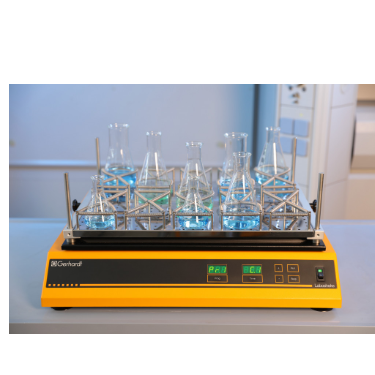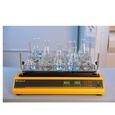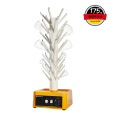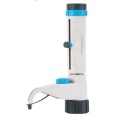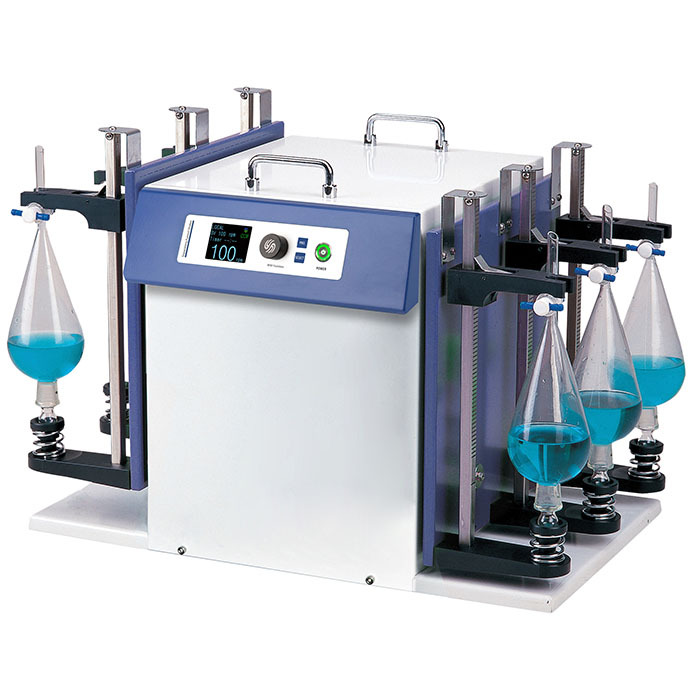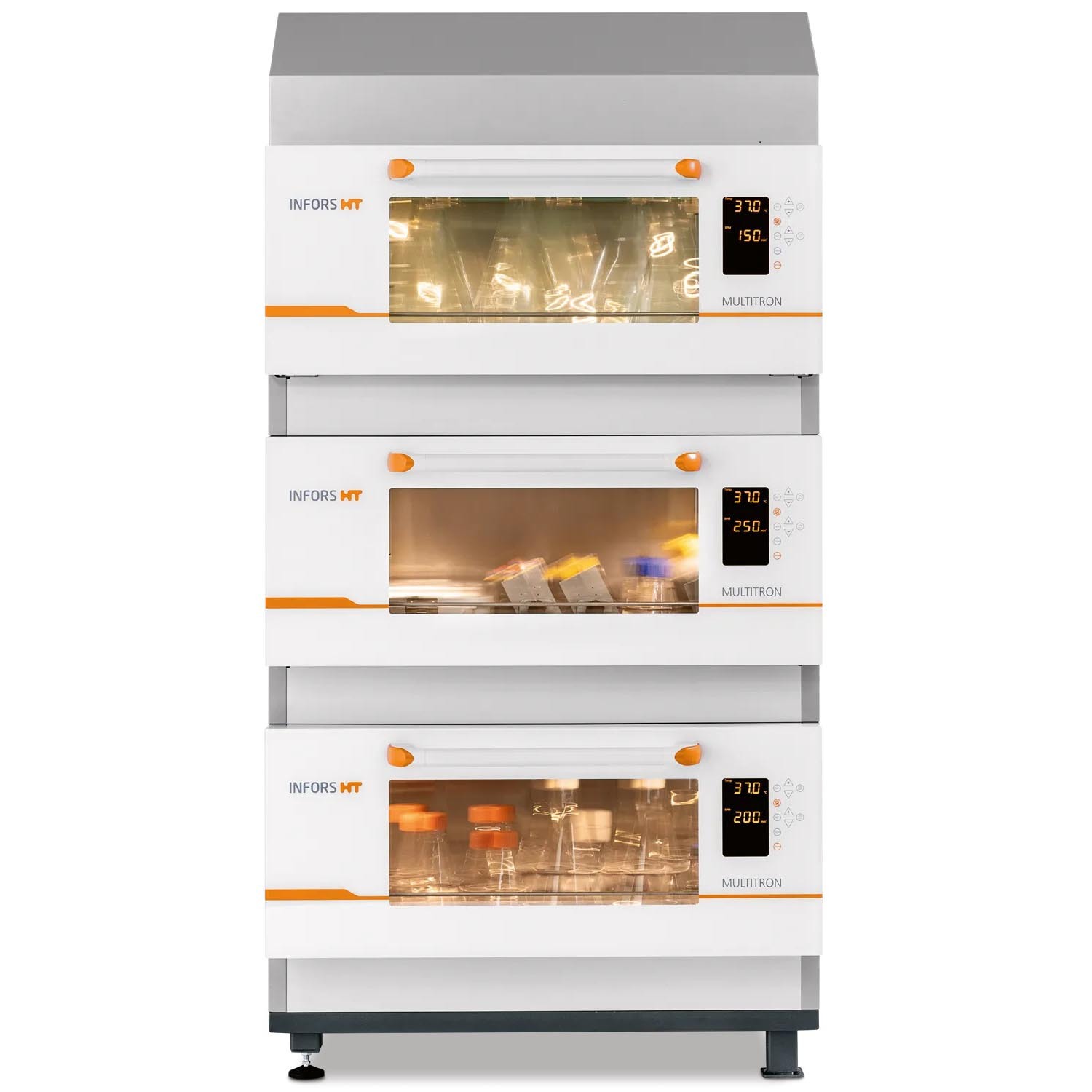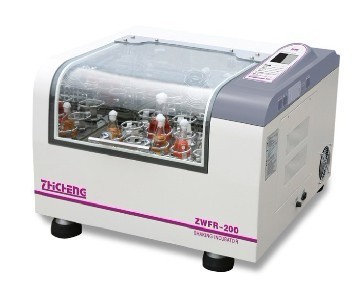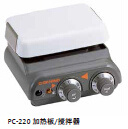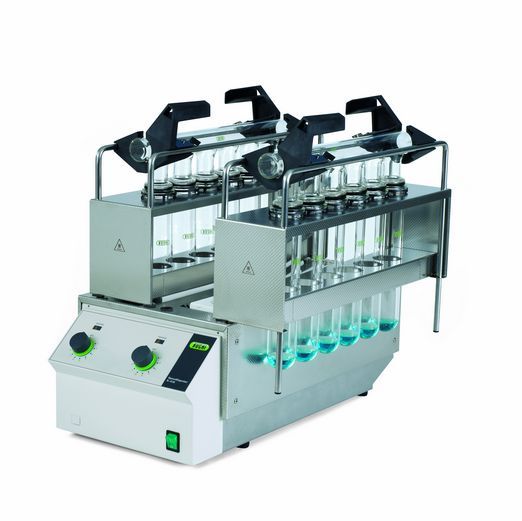方案详情
文
土壤与叶面碘施肥作为田间种植蔬菜的生物强化策略Soil versus foliar iodine fertilization as a biofortification strategy for field-grown vegetables
方案详情

土壤与叶面碘施肥作为田间种植蔬菜的生物强化策略Soil versus foliar iodine fertilization as a biofortification strategy for field-grown vegetablesfrontiersin Plant ScienceORIGINALRESEARCHpublished:23June2015doi:10.3389/fpls.2015.00450 IodinebiofortificationoffieldvegetablesLawsonetal. OPEN ACCESS Editedby: JanKofodSchjoerring, UniversityofCopenhagen,Denmark Reviewedby:JamesStangoulis,FlindersUniversity,Australia VictoriaFernandez,TechnicalUniversityofMadrid,Spain *Correspondence: DiemoDaum, DepartmentofPlantNutrition,Faculty ofAgriculturalSciences andLandscapeArchitecture,UniversityofAppliedSciences ofOsnabrück,Oldenburger Landstrasse24,49090Osnabrück,NDS,Germany d.daum@hs-osnabrueck.de Specialtysection:Thisarticlewassubmittedto PlantNutrition,asectionofthejournal FrontiersinPlantScience Received:09March2015 Accepted:01June2015 Published:23June2015 Citation: LawsonPG,DaumD,CzaudernaR,MeuserHandHärtlingJW(2015)Soil versusfoliariodinefertilization asabiofortificationstrategy forfield-grownvegetables.Front.PlantSci.6:450.doi:10.3389/fpls.2015.00450 土壤与叶面碘施肥作为田间种植蔬菜的生物强化策略 Soilversusfoliariodinefertilizationasabiofortificationstrategyfor field-grownvegetables PatrickG.Lawson1,DiemoDaum1*,RomanCzauderna1,HelmutMeuser2and JoachimW.Härtling3 德国奥斯纳布鲁克应用科学大学农业科学与风景园林学院植物营养系1DepartmentofPlantNutrition,FacultyofAgriculturalSciencesandLandscapeArchitecture,UniversityofAppliedSciences ofOsnabrück,Osnabrück,Germany,2DepartmentofSoilProtectionandRestoration,FacultyofAgriculturalSciencesand LandscapeArchitecture,UniversityofAppliedSciencesofOsnabrück,Osnabrück,Germany,3DepartmentofCultural StudiesandGeosciences,InstituteofGeography,UniversityofOsnabrück,Osnabrück,Germany 德国奥斯纳布鲁克大学地理研究所文化研究和地球科学系 Iodine(I)biofortificationofvegetablesbymeansofsoilandfoliarapplicationswas investigatedinfieldexperimentsonasandyloamsoil.Supplyofiodinetothesoil intrialplotsfertilizedwithpotassiumiodide(KI)andpotassiumiodatedirectlybeforeplanting(0,1.0,2.5,7.5,and15kgIha−1)increasedtheiodineconcentrationinthe edibleplantparts.Thehighestiodineaccumulationlevelswereobservedinthefirst growingseason:Inbutterheadlettuceandkohlrabithedesirediodinecontent[50–100wgI(100gFM)−1]wasobtainedorexceededatafertilizerrateof7.5kgIO3−-I ha−1withoutasignificantyieldreductionorimpairmentofthemarketablequality.In contrast,supplyingKIatthesamerateresultedinamuchloweriodineenrichment andclearlyvisiblegrowthimpairment.Soilappliediodinewasphytoavailableonlyfor ashortperiodoftimeasindicatedbyarapiddeclineofCaCl2-extractableiodinein thetopsoil.Consequently,long-termeffectsofaone-timeiodinesoilfertilizationcould notbeobserved.Acomparisonbetweenthesoilandthefoliarfertilizationrevealeda betterperformanceofiodineappliedaeriallytobutterheadlettuce,whichreachedthedesirediodineaccumulationinedibleplantpartsatafertilizerrateof0.5kgI−-Iha−1.Incontrast,theiodinecontentinthetuberofsprayedkohlrabiremainedfarbelowthe targetedrange.Theresultsindicatethatasufficientspreadingofiodineappliedonthe edibleplantpartsiscrucialfortheefficiencyofthefoliarapproachandleafyvegetables arethemoresuitabletargetcrops.Thelowiodinedosesneededaswellastheeasyand inexpensiveapplicationmayfavortheimplementationoffoliarspraysasthepreferred iodinebiofortificationstrategyinpractice. Keywords:iodine,micronutrientmalnutrition,biofortification,soilapplication,foliarsprays Introduction Iodineplaysavitalroleinhumanhealthandmustberegularlysuppliedinasufficientquantitytoensuretheproperfunctioningoffundamentalphysiologicalprocesses.The adverseeffectsofiodinedeficiency–intellectualimpairment,damagedreproduction,goiteraswellashypo-andhyperthyroidism–arestillaseriousglobalpublichealthproblem.AccordingtocurrentWorldHealthOrganization(WHO)data,almost1.9billionindividualsworldwidehaveaninadequateiodineintake.ComparedtootherWHOregions,Europehas thelargestpercentageofiodine-deficientpeopleintheirpopulation,despiteitsrelativewealthandhighstandardofhealth care(ZimmermannandAndersson,2011;Anderssonetal.,2012).Althoughtheuseofiodizedtablesaltinhouseholdshas beenwell-establishedinGermanysincethe1990s(Scribaetal.,2007),about40%ofschoolagechildrenstillhaveaninsufficient iodineintake(Thammetal.,2007). The recommendations by several institutions andorganizationsforasufficientdailysupplyofiodinetoadolescents andadultsrangebetween150and200pgId−1;pregnantandlactatingwomenhavehigheriodineneedsamountingto230and 260tgId−1,respectively,(EuropeanFoodSafetyAuthority[EFSA],2006;InstituteofMedicine[IOM],2006;Ankeand Arnhold,2008;ArbeitskreisJodmangel[AJ],2013).Accordingtothelatestnationwideiodinemonitoring,themeaniodineintake oftheGermanpopulationwas119ngId−1,approximately30%belowtheiodinerequirementsofanadultperson(Manzetal.,199T 8)h.eagronomicbiofortificationoffoodplantswithiodine wassuggestedasanewstrategytoaddresshumaniodinedeficiency.Byapplyingiodine-containingsaltsoriodine-rich organicmaterials(e.g.,seaweed)tosoils,cropsareabletoincreasetheabsorptionandaccumulationofthistraceelement.Iodineinfoodisreadilybioavailable(upto99%)andcanbeeasilyassimilated(Wengetal.,2014).Tonaccheraetal.(2013)investigatedtheefficiencyofiodineprophylaxisinhumansbyconsumptionofdifferentbiofortifiedvegetablesandrecorded asignificantincreaseofthemeanurinaryiodineexcretion,whichcloselyreflectstheiodineintakeofhumans.Furthermore,vegetablesbiofortifiedwithiodinebymeansoffoliarsprays(Comandinietal.,2013)orsoilapplications(Wengetal.,2014)showedahighstabilityofiodineduringdifferentdomesticcookingprocedures.Onthecontrary,iodineaddedasiodized tablesalttothecookingwaterofnon-biofortifiedvegetableswassubjecttosubstantiallossesduringtheboilingprocess. ConsideringthenutritionaliodinegapsinGermany(40–135ngId−1;ArbeitskreisJodmangel[AJ],2009,2013),a projectediodineconcentrationrangeof50–100ugI(100gFM)−1inbiofortifiedvegetables(averageportionof80gper individualperday)would,toalargeextent,coverthedietaryiodinedeficiency.Forhigheriodineneeds,thevegetableportions couldbeincreasedasnecessary.Theindicatedtargetrangeseemstobeareasonableconcentrationlevelforbiofortifiedvegetables withoutrunningtheriskofexceedingtheuppertolerableintakelevel(600–1100 gId−1)foriodine(EuropeanFoodSafety Authority[EFSA],2006;InstituteofMedicine[IOM],2006). Mostiodinesoilfertilizationtrialsconductedtodatewerecarriedoutaspotexperimentsingreenhousesundercontrolled ambientconditions(BorstPauwels,1961;Muramatsuetal.,1989;Daietal.,2004;Hongetal.,2008).Thestudiesshowed characteristicresponsepatternsdependingontheoxidationstateoftheelement(I−/IO3−)aswellastheappliediodinedose andtheexaminedplantspecies.Applicableconcentrationsintherangeof5–25mgI(kgsoil)−1(≈15–75kgIha−1inthe0–30cm soillayer)withoutyieldimpairmenthavebeenreported(Daietal.,2004;Hongetal.,2008).Ourownpreliminarypottrials withbutterheadlettucecultivatedinpeatgrowingmediashowed thatconcentrationsintherangeof1–2.5mgI(Lsubstrate)−1(≈3–7.5kgIha−1inthe0–30cmsoillayer)weresufficientto achieveanappropriateiodineaccumulationinedibleplantparts.Concentrationsofa1c0mgI(Lsubstrate)−1( 3p0kgIha−1in the0–30cmsoillayer)inducedyielddepression. Forthelarge-scalefertilizationofiodineingoiterendemicareas,theiodinationofirrigationwaterwasproposed(DeLong etal.,1997;Renetal.,2008).However,thismethodrequireslargeamountsofiodineandimpliesanuncontrollediodine releaseintotheenvironment.Anotherapproachcouldbetheincorporationofiodine-containingsaltsinliquidorgranular fertilizers.Commercialproductshavealreadybeenintroducedforthefertilizationofpasturestoimprovetheiodinesupply tograzinglivestock(Ravensdown,2014;Yara,2014).Practicaltechniquesfortheuseofstraightorcompoundiodinefertilizers onfieldvegetables,toenhancetheiodinecontentinedibleplantpartstoanadequateextent,havenotyetbeenestablished.Furthermore,littleinformationisavailableaboutthedurationoftheefficacyofaone-timesoilfertilizationwithiodine.Foliar spraysareknowntobeanefficientalternativetosoilfertilization,especiallyinthecaseofmicronutrients(EichertandFernández,2012).Nevertheless,onlyafewstudieshavehithertobeenconductedtocomparebothapplicationmethodswithregardto iodinebiofortificationpurposes(Smoleñetal.,2011a,b ). Inthepresentstudy,trialsunderopenfieldconditionswereconducted,usingleafy(butterheadlettuce)andtubervegetables (kohlrabi/radish),inordertoinvestigatethelong-termeffectsofaone-timeiodinesoilfertilizationandtocomparetheefficiency ofsoilversusfoliarfertilizationtechniques. MaterialsandMethods TrialSet-UpandGrowingConditions Theexperimentswerecarriedoutin2010and2011onsandyloamsoil(Sl3−4)atthehorticulturalresearchstationofthe UniversityofAppliedSciences,Osnabrück,Germany(siteWulveskamp:N52◦18i41.299en–E8◦1O30.31ii).Thetrialswere performedinasplit-plotdesignwiththreeorfourreplicationspertreatmentandagrossplotareaof4.5–9.5m2.Stocksolutions werepreparedinthelaboratorywithpurepotassiumiodideandpotassiumiodate(KIO3)salts(Ph.Eur.andRectapurR quality,VWRInternationalGmbH,Bruchsal,Germany).Thetrialplotswerethendrenchedwithdilutedstocksolutionsat differentconcentrations(0,1.0,2.5,7.5,and15kgIha−1),1daybeforeplantingatarateof2LH2Om−2.KIandKIO3foliarsprayswerepreparedfromstocksolutionsandappliedonceortwice(1or1and2weeks)beforeharvestatdifferent concentrations(1x0,1x0.5,2x0.5,1x1.0,and2x1.0kgIha−1)atarateof600LH2Oha−1.Thesprayedsolutionscontained theorganosiliconesurfactantBreak-ThruRsS240(0.05%v/v;AlzChemAG,Trostberg,Germany)toimprovespreadingand stickingproperties. PlantmaterialwaspurchasedatJungpflanzenLüskeGbR,Höltinghausen,Germany.Kohlrabi(BrassicaoleraceaL.var.gongylodesL.‘Lech’)andbutterheadlettuce(LactucasativaL.var.capitatacv.‘Barilla’)seedlingsgrowninpeatsubstrate weretransplantedintosoil(2010–2011)within2daysofdelivery.Radishseeds(RaphanussativusL.var.sativuscv.‘Raxe’;HildSamenGmbH,Marburg,Germany)weresowedin2011withasingle-seedprecisionhand-pushedseeddrill(Sembdner MaschinenbauGmbH,Fürstenfeldbruck,Germany)atadensityof160kernelm−2. EntecR 26(CompoGmbH&Co.KG,Münster,Germany),superphosphate (ICL Fertilizers Deutschland GmbH,Ludwigshafen,Germany)andpotassiummagnesia(K+SAG,Kassel,Germany)wereusedtocovertheN,P,K,andMg requirements.ThebasicN,P,andKfertilizationwasconductedmanually,3daysbeforeplantingorsowing,byspreadingthe granularfertilizersatthefollowingamounts:124kgNha−1,34kgP2O5ha−1,181kgK2Oha−1(butterheadlettucein2010);204kgNha−1,46kgP2O5ha−1,190kgK2Oha−1(kohlrabiin2010);110kgNha−1,21kgP2O5ha−1,101kgK2Oha−1(radishin2011);150kgNha−1,34kgP2O5ha−1,181kgK2Oha−1(butterheadlettucein2011). Climaticdatawerecollectedatthehorticulturalresearchstation(fordetaileddatareferto Lawson,2014).TheOsnabrück region,locatedinsouth-westernLower-Saxony,isgenerallycharacterizedbyawarm-moderateclimatewithmildwinters andcoolsummers.Thelong-termaveragesforminimumandmaximumairtemperature,rainfallandraindaysare1.8◦C (January),17.6◦C(July),865mm,and122days,respectively,(DeutscherWetterdienst[DWD],2013). 组织总碘含量测定 TissueTotalIodineDetermination Theplantmaterialharvestedforiodinedeterminationwaswashedthoroughlywithtapwaterinordertoimitateacommon domesticcleaningprocess:eachsamplewasimmergedinwaterandexcesswaterremovedwithasaladspinner,thenagain thoroughlyflushedwithtapwaterandexcesswaterremoved.Thesampleswerethentransferredtoadesiccatingovenwith airrecirculationanddriedat60◦Cuntilweightconstancy.The driedplantmaterialwasfinelygroundusinga500umsieveinanultra-centrifugalrotormill(modelZM100,RetschGmbH,Haan,Germany).Justbeforechemicaldigestion,thesamplesweredriedagainovernightat60◦Cinadesiccatingcabinetandre-cooledto roomtemperature. Thealkalinedigestionmethodusedwasadaptedfromtheproceduresdescribedby Jopkeetal.(1997)and Kuˇceraand Krausová (2007).Briefly,0.100goftheplantmaterialwereweighedinSigradurglassycarboncrucibles(typeGAT4,HTW GmbH,Thierhaupten,Germany)and1.678mLoftheKOHsolution(EmsureR@,47%v/v,MerckKGaA,Darmstadt,Germany)wereadded.Thecrucibleswerecoveredwithawatchglassandthensubjectedtoastepwiseheatingprocedure:uptoamaximum of300◦CwasachievedonaTrio-Termprecisionaluminumhotplateandthenupto450◦ConaCeranhotplate(modelC 450,C.GerhardtGmbH&CO.KG,Königswinter,Germany).Subsequently,thecrucibleswereplacedinamufflefurnaceat 550◦Cand,aftercooling,thefusioncakewassolubilizedby addingdeionizedwaterandplacingthecruciblesinanultrasonicbath(modelSonorexR Co.KG,Berlin,Germany).Thesolutionwasthenquantitativelytransferredtovolumetricflasks(100mL)byrinsingthecrucibles andthewatchglasseswithdeionizedwater(resultingina0.2MKOHmatrix). IodinedetectionwasperformedaccordingtotheQuick-Chem method 10-136-09-1-A (Switala, 2001), using a flowinjectionanalysis(FIA)systemmodelQuick-ChemR8500equippedwithanautomateddiluterandsampler,aniodidemanifoldandtheOmnionR 2.2.2software(allcomponents from Lachat Instruments, Hach Company,Loveland,CO,USA).Thequalitycontroloftheanalyticaldatawasestablishedbyrunningamethodcomparison (Quick-Chemmethod10-136-09-1-AcomparedtotheDINEN15111method;ThüringerUmweltinstitut, Henterich GmbH&Co.KG,Krauthausen,Germany)andasubsequentcorrelationanalysis.Arecoveryrateof92.5%,whichis comparabletothefindingsof Johneretal.(2012),wasfoundinsampleswithinaniodineconcentrationrangeof 2–190agIL−1. 土壤中氯化钙可提取碘测定 DeterminationofCalciumChlorideExtractable IodineinSoil Thecalciumchlorideextractableiodinefractioninsoilsampleswasextractedataratioof1+4(m+v)adaptingthe extractionmethodsuggestedby Altinoketal.(2003),whichisanalogoustotheprocedureoftheNminmethodtodetermine themineralnitrogencontentofsoils(VDLUFA,1997).150.00gofsoil(atactualfieldmoisturelevels)weresuspendedin 600mLofa0.0125MCaCl2-solutionin1000mLPE-bottlesandstirredmechanicallyfor1honareciprocalmotion shaker(modelLaboshakeRLS500,C.GerhardtGmbH&CO.KG,Königswinter,Germany).Thesoilsampleduplicates werethenfiltratedthroughafoldedfilter(typeMN619G1/4,Macherey-NagelGmbH&Co.KG,Dueren,Germany)andthefirst100mLofthepercolatewerediscarded.Duetoanincompatiblematrix,theiodinecontentsincalcium chlorideextractscouldnotbedetectedbyFIAandwere,therefore,determinedbyusinginductivelycoupledplasmamass spectrometry(ICP-MS)accordingtotheDINENISO17294-2method.Thisanalysiswascarriedoutbyanexternallaboratory (ThüringerUmweltinstitut,HenterichGmbH&Co.KG,Krauthausen,Germany). StatisticalProcedures Iodineconcentrationdataweresubjectedtoaone-wayANOVAand,ifneeded,toanormalizationprocedurebyeither usinglogarithmic,squarerootorBox–Coxtransformations.Ifnormalizationwasnotpossible,thedatawastransformedinto ranksandthenanalyzedbymeansofparameter-freemethods(Wilcoxonrank-sumtestandFriedman’sranktestifbalanced datawasavailable). Additionally,amultifactorialGLMANOVAwasperformedtotestthetrialfactorsandtheirinteraction(iodineform,iodinedose,form×dose).TheBonferronimultiplecomparisonprocedureatα=0.05wasusedtocomparethemeans.All thestatisticaltestswereconducted,withtheexceptionoftheBox–Coxtransformation(SPSSR 20),usingtheprogramNCSS 2007. Results YieldandMarketableQuality Theinfluenceofdifferentiodinefertilizationtechniquesoncropyieldandmarketablequalitywasinvestigatedusing butterheadlettuceandkohlrabi/radishasmodelcrops.Afteraone-timesoilfertilizationofKIandKIO3,differencesin biomassproductionwerenotstatisticallysignificantinanycase(Table1).However,inthefirstgrowingseason,thelowest meancropyieldswerenoticedatthehighestiodinesupplylevel.Atthesametime,thecroppopulationbecamemore inhomogeneouscomparedtothecontrolplants.Figures1A–Fillustrateforbutterheadlettucetheaveragedevelopmentof headsizeandvariabilityasaffectedbyincreasingfertilizerdoses.Afewdaysafterplanting,butterheadlettucetransplants cultivatedat15kgI−-Iha−1developedchloroticleaveswith yellowintercostalleafareas(Figure2C)turningincreasinglyintonecroticspots.Althoughshowinggrowthinhibition,mostplantletsrecoveredwithinashortperiodoftime.Aniodinesupplyupto7.5kgIha−1appliedasKIO3didnot affectgrowthorthemarketablequalityoftheinvestigated croIpns.thecaseoffoliarsprays(KIandKIO3appliedonceortwice atarateof0.5or1.0kgIha−1),thebiomassproductionand themarketablequalityofbutterheadlettuceandkohlrabiwerenotaffectedsignificantlybytheiodinesupply(Table2).Avisual comparisonofthefoliarspraysappliedtobutterheadlettucealsoindicatednonoticeabledifferencesfromtheunfortified controlintheoverallheadsizewithincreasingfertilizerdose(Figures1G–L). InfluenceofaOne-TimeIodineSoil FertilizationOverTwoGrowingSeasons Figure3Ashowstheiodineaccumulationbehaviorofkohlrabicultivatedinthefirstseasonafterasingleiodinesoilfertilization appliedjustbeforeplantingin2010.Anincreasingiodinecontentinedibleplantpartswasobservedwitharising iodinesupply,particularlywhenusingKIO3astheiodine fertilizer.Thedesirableiodineamountinedibleplantpartswasachievedat≥7.5kgIO3−-Iha−1.KItreatmentswere lesseffectiveanddidnotreachthetargetrange[50–100pgI(100gFM)−1]inanyvariantusingkohlrabiasamodel cropA.similarpattern,butathigheraccumulationlevels,wasfound inbutterheadlettucecultivatedin2010(Figure3B).Again,anincreasingiodinecontentwithrisingiodinesupplyanda higheraccumulationtendencyoftrialvariantstreatedwithKIO3wasobserved.Significantdifferencestotheunfortifiedcontrol occurredat≥7.5kgIO3−-Iha−1wheretheintendediodinelevelwasexceededtotheextentof50–300%.InKI-treatmentsatthe sameiodinedoses,asignificantlyloweriodineaccumulationwasfound;thetargetrangewasreachedatonly15kgI−-Iha−1. Inthesecondseason(2011),therotationalcropscultivatedonthesameplots(butterheadlettuceafterkohlrabiandradish afterbutterheadlettuce)withoutfurtheriodinefertilizationshowedonlylittleornoiodineaccumulation(Figures4A,B).Inbothsucceedingcrops,asinglesignificantdifferencetobothunfortifiedcontrolswasfoundinplotsfertilizedwith15kgIO3−-Iha−1oneyearbefore.Evenatthisdose,therecordediodine accumulationwasdistinctlybelowthedesiredrange. OnlylittledifferenceswererecordedintheCaCl2-extractableiodinecontentofsoilsamplescollectedbeforeand6months aftertheiodinesoilfertilization(Figure5A).Althoughaslightincreaseofiodineconcentrationinthesoilwasobservedwith increasingiodinefertilizerdoses(especiallysoildepthsof60–90cmincaseofKIO3),nostatisticallysignificantdifferencesto thecontroltreatmentortotheambientlevelvaluebeforethefertilizationoccurred,weredetected. Thedecreaseiniodinerecoveryfollowingaone-timeiodinefertilizationwith7.5kgIO3−-Iha−1atshortersamplecollection intervalswasremarkable(Figure5B).ArapidreductionintheCaCl2-extractableiodineconcentrationwasrecordedwithinthe firstweek.Threeweeksaftertheinitialapplication,themajorityoftheexogenouslyappliediodinewasnolongerdetectableinthe topsoilwithoutindicationsofiodinedisplacementinthedeepersoillayer(15–30cm). Crop Kohlrabi Butterheadlettuce Radish Cultivationyear 2010 2011 Iodineform I− IO3− I− IO3− I− IO3− I− IO3− Treatmentdose[kgIha−1] Relativecropyield[%] 0 100.0a 100.0a 100.0a 100.0a 100.0a 100.0a 100.0a 100.0a 1.0 90.2a 98.6a 97.9a 92.0a 103.1a 93.9a 108.6a 94.0a 2.5 93.1a 106.5a 91.7a 94.3a 99.4a 105.5a 94.4a 100.0a 7.5 79.6a 100.2a 85.2a 94.2a 113.4a 102.1a 85.8a 97.1a 15 72.1a 95.5a 73.6a 72.7a 107.0a 98.1a 90.5a 89.2a FIGURE1|Avisualcomparisonofbutterheadlettuce1daybeforeharvest,cultivatedin2010usingdifferentapplicationmethods,iodine dosesandforms.Soilapplicationinseason2010:(A)0kgI−-Iha−1,(B)7.5kgI−-Iha−1,(C)15kgI−-Iha−1,(D)0kgIO3−-Iha−1,(E)7.5kg ComparisonbetweentheSoilandFoliar ApplicationMethod Figure6showstheiodineaccumulationbehaviorofkohlrabiandbutterheadlettuceasaffectedbyiodinefoliarsprays.Generally,thefoliarspraysappliedtokohlrabididnotleadtoasubstantialiodineaccumulationinedibleplantparts.Inallcases,thiswasfar belowthedesiredminimalamountof50sgI(100gFM)−1.The non-parametriccomparisontothecontrollevelshowedaslightiodineenhancementwhenapplyingKIatthehighestdose. Foliarspraytreatmentsonbutterheadlettuceledtoveryhighiodineaccumulationlevelsexceedingthesoilapplicationresults.Incontrasttothesoildrenches,amorepronouncediodineaccumulationtendencywasobservedintheiodidetreatments (Figure6B).Thetargetedaccumulationrangecouldalreadybereachedatthelowestdosesof0.5kgI−-Iha−1and2x0.5kg IO3−Iha−1. Discussion YieldandMarketableQuality Nostatisticallysignificantdifferencesinbiomassproductioncouldbeattributedtoaone-timeKIorKIO3soilapplication.However,afterafertilizationof15kgIha−1,themeancropyield ofbutterheadlettuceandkohlrabiwasupto28%lowercomparedtothecontrolplants(Table1).Furthermore,atthisiodinedose theheadsizeofbutterheadlettucewasvisiblyreducedand IO3−-Iha−1,(F)15kgIO3−-Iha−1.Foliarapplicationinseason2010:(G)0kgI−-Iha−1,(H)1kgI−-Iha−1,(I)2x1kgI−-Iha−1,(J)0kgIO3−-Iha−1,(K)1kgIO3−-Iha−1,(L)2x1kgIO3−-Iha−1.Theblackarrowsindicatesmallerheadswithinasingleplot. thecroppopulationbecamemoreinhomogeneous(Figure1).Phytotoxicsymptoms,includingchlorosisandnecroticspotson olderleaves,wereobservedintheveryearlydevelopmentalstageofbutterheadlettucetransplantswhenthehighestKIdosewas applied(Figure2).Consideringthatsoildrenchespresumablyinfiltratedonlyafewcentimeters(1.5–3cm)intothesoildirectly aftertheiodinefertilization(Tanakaetal.,2012),theinitialiodineconcentrationwasintherangeofapproximately33–66mgI−-I(kgsoil)−1andcouldhavecausedthedepicteddetrimental effects.Thiswouldbeinconcordancewiththeobservationsof Hongetal.(2008)and Wengetal.(2008)ondifferentvegetable speciesandthestateddeleteriouseffectsofaniodinedoseof≥50mgI−-I(kgsoil)−1. Littleisknownaboutthemechanismofiodidetoxicityinplants.However,atleastinpart,itmayarisefromintracellular oxidationofiodidetoelementaliodinefollowedbyiodinationofcellularcomponents,includingchlorophyll(MynettandWain,1973).SoilappliedKIO3didnotinducephytotoxicsymptomsinbutterheadlettucetransplants(Figure2).Furthermore,mean cropyieldwashardlyaffectedbyiodatesupply,especiallyinthecaseofkohlrabi(Table1).Theseobservationsareinagreement withpreviousreports,indicatingthattheinfluenceofiodideonplantgrowthismoreadversethaniodate(MackowiakandGrossl,1999;Zhuetal.,2003;Blascoetal.,2008;Caffagnietal.,2011). Theinhomogeneousplantgrowthwithinthesingleplots(especiallyatthehighestiodinetreatments)andnoticeable fluctuationsincropyieldbetweentheblocks(duetothe slopedandheterogeneousarablefieldatthetrialsite)affecteddatavariation.Consequently,thenoticedreductioninbiomass productionwasnotstatisticallysignificantinanycase(Table1).Despiteofthisvariationincropyield,theresultsofthesoil FIGURE2|Avisualcomparisonofbutterheadlettucesoilcubetransplants8daysafterplantingatdifferentiodinedosesappliedby meansofsoildrenches.(A)0kgI−-Iha−1,(C)7.5kgI−-Iha−1,(E)15kgI−-Iha−1,(B)0kgIO3−-Iha−1,(D)7.5kgIO3−-Iha−1,(F)15kgIO3−-I ha−1.Theblackarrowsindicatechloroticintercostalareasornecroticspots. fertilizationexperimentsclearlyindicatethatamoderateiodinedoseofupto7.5kgIha−1appliedasKIO3iswelltolerated bybutterheadlettuceandkohlrabi.Ontheotherhand,astimulationofplantgrowthfollowinglowiodineapplication rates,asoccasionallyreportedintheliterature(Hongetal.,2008;Wengetal.,2008),couldnotbeobservedinourtrials. Thevisualassessmentofbutterheadlettuce(Figure1)treatedwithfoliarspraysshowed,incomparisontothesoiliodine application,amuchmorehomogenousheadsizeacrossalltreatments.Noadverseeffectswerenoticedonleavesandmean cropyieldwasunaffecteduptoatotalapplicationamountof1kgIha−1(Table2).Inaccordancewiththeseobservations,Smoleñ etal.(2011a )alsofoundnosignificantdifferencesinbiomassproductioninsimilarfieldtrialsonbutterheadlettuce.Although statisticallynotsignificant,Altinoketal.(2003)reportedyieldpromotionofalfalfaforageusingpotassiumiodidefoliarsprays (1–2kgI−-Iha−1).Incontrast,Strzetelskyetal.(2010)statedyielddepressionaftersprayingradishwithKIat2×0.8kg Iha−1.Apparently,thegrowthresponsetoaeriallyappliediodineisdifferentbetweenplantspecies,buttotaldosesof>1kgIha−1maybecritical. EfficiencyofaOne-TimeIodineSoilFertilizationOverTime Thenativeiodineconcentrationofthefreshvegetablesinvestigatedinthisstudyrangedbetween1.2and16.3eg I(100gFM)−1andthuswasinaccordancewithvalues reportedpreviouslyinliterature(Ankeetal.,1993;Fordyce,2003;Haldimannetal.,2005).Afteraone-timeiodinesoilfertilization atratesof≥7.5kgIO3−-Iha−1butterheadlettuceandkohlrabiaccumulatediodineintheiredibleplantpartstoasatisfactory amount[≥50tgI(100gFM)−1].Incontrast,vegetablesgrown onthesameplotsinthesecondseasonwithoutfurtheriodinetreatmentdidnotaccumulateiodinetoanadequateextent (Figure4).Thus,longtermeffectsofiodineapplicationbymeansofsoildrenchescouldnotbeobserved. Crop Kohlrabi Butterheadlettuce Applicationmethod Soildrenches Foliarsprays Soildrenches Foliarsprays Iodineform I− IO3− I− IO3− I− IO3− I− IO3− Treatmentdose[kgIha−1] Soildrenches Foliarsprays Relativecropyield[%] 0 0 100.0a 100.0a 100.0a 100.0a 100.0a 100.0a 100.0a 100.0a 1.0 0.5 90.2a 98.6a 100.6a 93.5a 97.9a 92.0a 98.3a 107.4a 2.5 2x0.5 93.1a 106.5a 104.7a 98.6a 91.7a 94.3a 89.5a 99.2a 7.5 1.0 79.6a 100.2a 99.7a 97.4a 85.2a 94.2a 94.9a 99.2a 15 2x1.0 72.1a 95.5a 98.0a 95.8a 73.6a 72.7a 86.8a 91.9a One-wayANOVA(p-value) NS(0.181) NS(0.875) NS(0.389) NS(0.099) FIGURE3|Theiodineaccumulationbehaviorof(A)kohlrabiand(B)butterheadlettucecultivatedinseason2010afteraone-timeiodine soilfertilizationapplied2010.MeanswithsamelettersdonotdifferaccordingtoBonferroniMCPata=0.05[One-wayanalysisofvariance(A):probabilitylevel=0.00,power=1.00;One-wayanalysisofvariance(B):probabilitylevel=0.00,power=1.00].n=3. Theresponseofvegetablestoaone-timeiodinesoilfertilizationwasconditionedprimarilybytheappliediodineform anddose,thecropusedandtheelapsedtime.HigheriodineconcentrationsinvegetableswerefoundthroughoutintheKIO3treatmentsintheexperiments.Thisresultisconsistentwiththefindingsof Daietal.(2006)and Wengetal.(2008)who alsoreporteddistinctivelyhigheriodineaccumulationfertilizingwiththeoxidizediodineform.Theinherentdifferencebetween thetwoiodineformsislikelytobearesultofthehighermobilityandturnoverofI−insoils.Iodideleachesfromthe rootzonemorequickly,isreadilyfixedinhumusandrapidlyvolatilizesintheformoforganoiodidessuchasmethyliodide (MuramatsuandYoshida,1995;Fuge,1996;Redekeretal.,2000;Dimmeretal.,2001;Johnson,2003).Consequently,iodideis eithermorerapidlylostafteritsapplicationtosoilsorremainslessphytoavailableintherootzonethaniodate.Ontheother hand,studiesonplantsgrowninhydroponicsystemshaveshownthatrootsabsorbI−atahigherratethanIO3−(Zhuetal.,2003;Blascoetal.,2008;Voogtetal.,2010).Thisisattributedtotheheaviermolecularweightandthehighervalenceofiodate (MackowiakandGrossl,1999).Furthermore,itissupposedthatIO3−isreducedtoI−beforeitsuptakebyplantrootsandthus FIGURE4|Theiodineaccumulationbehaviorof(A)butterheadlettuceand(B)radishcultivatedinseason2011afteraone-timeiodinesoil fertilizationapplied2010.MeanswithsamelettersdonotdifferaccordingtoBonferroniMCPata=0.05[One-wayanalysisofvariance(A):probability level=0.037115,power=0.805387;one-wayanalysisofvariance(B):probabilitylevel=0.000012,power=0.99999].n=3. theslowabsorbtionrateofiodateislimitedbythereductionprocess(BöszörmènyiandCseh,1960;Zhuetal.,2003).Recent investigationsonriceindicatethattheiodatereductionactivityinrootsrespondstotheexternaliodineconcentration(Kato etal.,2013).Overall,itseemsthatI−ismorereadilyplant availableinthesolutionofsoillessculturesystemswhereas,underfieldconditions,itismoresubjecttocumulativelosses thanIO3−. Butterheadlettuceandkohlrabishowedaremarkabledifferenceintheiodineaccumulationbehavior:Butterhead lettuceprovedtobeaverygoodiodineaccumulatorsincethiscropdistinctlyexceededthedesirediodineconcentrationin edibleplantpartsatthehighestfertilizationrate.Hence,anamountofapproximately5kgIO3−-Iha−1wouldprobablybe sufficienttoreachthetargetlevelrange.Althoughkohlrabihadalessaccentuatedresponsetotheiodinetreatments,satisfactory resultswereachievedat7.5kgIO3−-Iha−1. Thesoilanalysesafterthefirstcultivationseason(Figure5A)revealedalargedecreaseinCaCl2-extractableiodine.This explainsthelowiodineaccumulationincropsinthesecondseasonandemphasizestheshort-termavailabilityofthefertilized FIGURE5|(A)Calciumchlorideextractableiodine(12.5mMCaCl2solution)atdifferentdepthsinasandyloamsoil(Sl3)beforeandsixmonthsafteriodinefertilizationbymeansofsoildrenchesatdifferentconcentrations.Meanswith samelettersdonotdifferaccordingtoBonferroniMCPatα=0.05(One-wayanalysisofvariance:probabilitylevel=0.053,power=0.78).n=3.(B)Calciumchlorideextractableiodineinsoilsamplescollectedatdifferentintervalsafteraone-timeiodinefertilizationat7.5kgIO3−-Iha−1(One-way analysisofvariance:probabilitylevel=0.00,power=1.00).n=4. iodineinsoil.Thepostponedtrialwithasoilsamplecollectionatshortintervals(Figure5B)showedthat,evenwhenfertilizing iodineinitsoxidizedform,averyquickandsignificantiodinelosswithoutdisplacementintothedeepersoillayersoccurs.Hence,theleachingofiodineseemstobe,atleastforthetestedsoil(Sl3−4),aminorpathwayofloss,whichconfirms similarobservationsby Wengetal.(2009).Otherpotentialiodinesinksmaybe,asmentionedabove,themicrobialformation oforganoiodides,thefixationofiodineintothesoilorganicmatteraswellasitsadsorptiononironandaluminumoxides (Whitehead,1978,1981,1984).Inaddition,theoxidizingeffectofdifferentbacterialstrainsandenzymesmaybeof importancefortheimmobilizationofiodineinsoils(MuramatsuandAmachi,2007;Shimamotoetal.,2011;Suzukietal.,201R 2e).gardlessofthereasonsfortheobservediodinedynamic inthesoil,thechangesoccurredveryquickly.Withinthreeweeks,theconcentrationofCaC2-extractableiodinedeclined totheambientlevelofthesoil(Figure5B).Thisdevelopmentaffectedthecropsinvestigatedduringthefirstgrowingseasonto Kohlrabifoliarspraydata(non-normal)wastransformedintoranksand comparedtorespectivecontrolbyWilcoxonrank-sumtest.n=4. adifferentextent:Thefasterdevelopingbutterheadlettucespentahigherpercentageofitstotalcultivationperiod(6weeks)inan iodine-enrichedsubstratecomparedtokohlrabi(totalcultivationperiod8weeks).Hence,theiodineapplicationpointintimein relationtothegrowthpatternofthevegetablespecieshastoberecognizedasacrucialfactor,sincelong-termeffectsthrough iodinefertilizationcannotbeexpected. EfficiencyComparisonBetweentheSoilandtheFoliarApplicationMethod Thedifferentapplicationtechniques–soilvs.foliarfertilization–revealedapronounceddifferenceintheiodineaccumulation behaviordependingonthevegetablespeciesstudied.Butterheadlettuceshowedhigheraccumulationrateswhenapplyingiodine bymeansoffoliarsprays.Incontrasttosoilapplication(Figure3B),ahigheriodineaccumulationintheedibleparts wasobservedusingKIastheiodinefertilizer(Figure6B)andthetargetediodinecontentwasalreadyobtainedatthe lowestfertilizerrateof0.5kgI−-Iha−1.Thus,thefoliar fertilizationtechniquewasdistinctlymoreefficientfortheiodinebiofortificationofbutterheadlettuceanditcanbeassumedthat anumberofotherleafyvegetableswillshowasimilarresponse,asinvestigationsonaselectionofvegetablescropshaveshown (Lawson,2014).However,Smoleñetal.(2011a )achievedastatisticallysignificantdifferenceiniodineaccumulationspraying butterheadlettuceonlyatthehighestfertilizationdoseof4x2kgIO3−-Iha−1.Thisdeviatingresultmaybeexplainedbyarather highiodinelevelinthecontroltreatment(about10timeshigherthaninourstudy)andalackofsurfactantsinthefoliarspray solutions. Thepost-harvesttreatmentchoseninourinvestigationsincludedthoroughwashingoftheproduceunderflowingtap waterandthuswasinaccordancewiththedomesticcleaningprocesscommonlyusedforfreshvegetables.Therefore,the resultsforbutterheadlettucearereflectingtheactualiodineconcentrationinready-to-eatsalads.Theshareofiodinewhich isonlyweaklyadheringontheleafsurfacewillpresumablyberemovedbythedescribedprocedure.However,investigations withtheaidofradioiodineshowedthatfoliarappliedIcouldbewashedoffonlywithinafewhoursafterapplication(Oestling etal.,1989),thusindicatingthataeriallyappliediodinemayberapidlyabsorbedbyleaves.Furthermore,greenhousetrialswith pottedherbssprayedwithKIandKIO3showednosignificantdifferencesbetweenthoroughlywashedandunwashedsamples (Lawson,2014). Inthecaseofkohlrabi,satisfactoryresultsiniodineaccumulationcouldonlybeachievedbymeansofsoilfertilization References Altinok,S.,Sözüdogˇru,S.,andHalilova,H.(2003).Effectofiodinetreatments onforageyieldsofalfalfa.Commun.SoilSci.PlantAnal.34,55–64.doi:10.1081/CSS-120017415 Andersson,M.,Karumbunathan,V.,andZimmermann,M.B.(2012).Globaliodinestatusin2011andtrendsoverthepastdecade.J.Nutr.142,744–750.doi:10.3945/jn.111.149393 Anke,M.,andArnhold,W.(2008).DasSpurenelementIod.ZuwenigundzuvielschadetdemOrganismus.BiologieUnsererZeit38,400–406.doi:10.1002/biuz.200610370 Anke,M.,Groppel,B.,andBauch,K.-H.(1993).“Iodineinthefood,”in:IodineDeficiencyinEurope–Acontinuingconcern.NATOASISeries,SeriesA:Life Sciences,Vol.241,edsF.Delange,J.T.Dunn,andD.Glinoer(NewYork:PlenumPublishingCooperation),151–158.doi:10.1007/978-1-4899-1245-9_18 ArbeitskreisJodmangel[AJ].(2009).DatenundFaktenzumStanddesJodmangelsundderJodversorgunginDeutschland.Jodversorgungaktuell,Ausgabe2009.A.J.Organisationsstelle,Leimenrode29,60322FrankfurtamMain,6. ArbeitskreisJodmangel[AJ].(2013).JodmangelundJodversorgunginDeutschland.AktuelleszumderzeitigenVersorgungsstandundHandlungsbedarf.4.Auflage,Stand:Januar2013.A.J.Organisationsstelle,Leimenrode29,60322Frankfurt amMain,11. Blasco,B.,Rios,J.J.,Cervilla,L.M.,Sánchez-Rodrigez,E.,Ruiz,J.M.,andRomero,L.(2008).Iodinebiofortificationandantioxidantcapacityoflettuce:potentialbenefitsforcultivationandhumanhealth.Ann.Appl.Biol.152,289–299.doi:10.1111/j.1744-7348.2008.00217.x BorstPauwels,G.W.F.H.(1961).Iodineasamicronutrientforplants.PlantSoil14,377–392.doi:10.1007/BF01666295 Böszörmènyi,Z.,andCseh,E.(1960).Theuptakeandreductionofiodatebywheat roots.Curr.Sci.29,340–341. (Figure3A).Thelowiodinelevelsfoundinthekohlrabistemtuberasaresultoffoliarsprays(Figure6A)indicatea marginaliodinephloemmobilityaspreviouslyreportedbyotherauthors(Herrettetal.,1962;Blascoetal.,2008;Voogtetal.,2010).Furthermore,thehighlyhydrophobicleafcuticlelayersofkohlrabimayhavesubstantiallyconstrainedtheuptakeofiodine and,consequently,limiteditstranslocationintotheedibleplantpart. Conclusion Ourresultsdemonstratethatiodinefoliarspraysareasuitablemethodtoincreasetheiodinecontentofbutterheadlettuce toanappropriatelevelwithoutyieldreductionorimpairmentinthemarketablequality.Thelowiodinedosesneededas wellastheeasyandinexpensiveapplicationoffoliarspraysmayfavoritsimplementationinpractice.Therefore,thisiodine biofortificationapproachshouldbefurtherelaborated,especiallyforleafyvegetables. Acknowledgment Thefollowinginstitutionsaregratefullyacknowledgedfortheirfinancialsupport:UniversityofAppliedSciencesofOsnabrück andtheFederalMinistryforEducationandResearch(GrantNo.17N0210;Fundingline“IngenieurNachwuchs”). Caffagni,A.,Arru,L.,Meriggi,P.,Milc,J.,Perata,P.,andPecchioni,N.(2011).Iodinefortificationplantscreeningprocessandaccumulationintomatofruitsandpotatotubers.Commun.SoilSci.PlantAnal.42,706–718.doi:10.4081/ija.2012.e32 Comandini,P.,Cerretani,L.,Rinaldi,M.,Cicchelli,A.,andCiavaro,E.(2013).Stabilityofiodineduringcooking:investigationonbiofortifiedandnotfortifiedvegetables.Int.J.FoodSci.Nutr.64,7,857–861.doi:10.3109/09637486.2013.798270 Dai,J.-L.,Zhu,Y.-G.,Huang,Y.-Z.,Zhang,M.,andSong,J.L.(2006).Availabilityofiodideandiodatetospinach(SpinaciaoleraceaL.)inrelationtototal iodineinsoilsolution.Plantsoil289,301–308.doi:10.1007/s11104-006-9139-7 Dai,J.-L.,Zhu,Y.-G.,Zhang,M.,andHuang,Y.-Z.(2004).Selectingiodine-enrichedvegetablesandtheresidualeffectofiodateapplicationtosoil.Biol.TraceElem.Res.3,265–276.doi:10.1385/BTER:101:3:265 DeLong,G.R.,Leslie,P.W.,Wang,S.-H.,Jiang,X.-M.,Zhang,M.-L.,Rakeman,M.A.,etal.(1997).Effectoninfantmortalityofiodinationofirrigationwaterinaseverelyiodine-deficientareaofChina.Lancet350,771–773.doi:10.1016/S0140-6736(96)12365-5 DeutscherWetterdienst[DWD].(2013).Availableat:http://www.dwd.de/[accessedMarch23,2013]. Dimmer, C., Simmonds, P. G., Nickless, G., and Bassford, M. R.(2001). Biogenic fluxes of halomethanes from Irish peatland ecosystems.Atmos.Environ.35,321–330.doi:10.1016/S1352-2310(00)00151-5 Eichert,T.,andFernández,V.(2012).“Uptakeandreleaseofmineralelementsby leavesandotheraerialplantparts,”inMarschner’sMineralNutritionofHigherPlants,3rdEdn,ed.P.Marschner(SanDiego,CA:AcademicPress),71–84. EuropeanFoodSafetyAuthority[EFSA].(2006).Tolerableupperintakelevelsforvitaminsandminerals.ScientificCommitteeonFood–ScientificPanelon DieteticProducts,NutritionandAllergies.Eur.FoodSafetyAuthority,480. Fordyce,F.M.(2003).DatabaseoftheIodineContentofFoodandDietPopulatedwithDatafromPublishedLiterature.CR/03/084N.(Nottingham:BritishGeologicalSurvey),50. Fuge,R.(1996).Geochemistryofiodineinrelationtoiodinedeficiency diseases. Geol. Soc. Lond. 113, 201–211. doi: 10.1144/GSL.SP.1996.113.01.16 Haldimann,M.,Alt,A.,Blanc,A.,andBlondeau,K.(2005).Iodinecontentoffoodgroups.J.FoodComp.Anal.18,461–471.doi:10.1016/j.jfca.2004.06.003 Herrett,R.A.,Hatfield,H.H.,Crosby,D.H.,andVlitos,A.J.(1962).Leafabscissioninducedbytheiodideion.PlantPhysiol.37,358–363.doi:10.1104/pp.37.3.358 Hong,C.-L.,Weng,H.-X.,Qin,Y.-C.,Yan,A.-L.,andXie,L.-L.(2008).Transferofiodinefromsoiltovegetablesbyapplyingexogenousiodine.Agron.Sustain.Dev.28,575–583.doi:10.1051/agro:2008033 InstituteofMedicine[IOM].(2006).DietaryReferenceIntakes–TheEssentialGuidetoNutrientIntakes.InstituteofMedicine.Washington,DC:TheNational AcademicPress. Johner,A.S.,vonNida,K.,Jahreis,G.,andRemer,T.(2012).Aktuelle UntersuchungenzeitlicherTrendsundsaisonalerEffektedesJodgehaltesinKuhmilch–UntersuchungenausNordrheinWestfalen.Berl.Münch.Tierärztl.Wochenschr.125,76–82.doi:10.2376/0005-9366-125-76 Johnson,C.C.(2003).TheGeochemistryofIodineanditsApplicationtoEnvironmentalStrategiesforReducingRisksfromIodineDeficiencyDisorders.BritishGeologicalSurveyCommissionedReportCR/03/057N.Keyworth,Nottingham:DepartmentforInternationalDevelopment,DFIDKARProject R7411,54. Jopke,P.,Fleckenstein,J.,Schnug,E.,andBahadir,M.(1997).SpurenanalytikvonIodinBödenundPflanzen.Analytiker-Taschenbuch,15,121–145.doi:10.1007/978-3-642-60430-0_4 Kato,S.,Wachi,T.,Yoshihira,K.,Nakagawa,T.,Ishikawa,A.,Takagi,D.,etal.(2013).Rice(OryzasativaL.)rootshaveiodatereductionactivityinresponseto iodine.Front.PlantSci.4:227.doi:10.3389/fpls.2013.00227 Kuˇcera,J.,andKrausová,I.(2007).Fastdecompositionofbiologicalandother materialsforradiochemicalactivationanalysis:aradiochemicalstudyofelementrecoveriesfollowingalkaline-oxidativefusion.J.Radioanl.Nucl.Chem.271,577–580.doi:10.1007/s10967-007-0309-8 Lawson,P.G.(2014).DevelopmentandEvaluationofIodineBiofortificationStrategiesforVegetables.Berlin:LogosVerlag,192. Mackowiak,C.L.,andGrossl,P.R.(1999).Iodateandiodideeffectsoniodine uptakeandpartitioninginrice(OryzasativaL.)growninsolutionculture.PlantSoil212,135–143.doi:10.1023/A:1004666607330 Manz,F.,Anke,M.,Bohnet,H.G.,Gärtner,R.,Großklaus,R.,Klett,M.,etal.(1998).Jod-Monitoring1998:RepräsentativeStudiezurErfassungdes JodversorgungszustandesderBevölkerungDeutschlands.Abschlussbericht desForschungsvorhabens“Jod-Monitoring”desBMG.SchriftenreihedesBundesministeriums fürGesundheit,Band110,Baden-Baden,Nomos Verlagsgesellschaft,264. Muramatsu,Y.,andAmachi,S.(2007).Awardsceremonyspeechesandabstractsofthe17thannualV.M.Goldschmidtconferencecologne,Germany.Geochimica etCosmochimicaActa71(Suppl.15),A607–A697. Muramatsu,Y.,Uchida,S.,Sumiya,M.,Ohmomo,Y.,andObata,H.(1989).Tracer experimentsontransferofradioiodineinthesoil-riceplantsystem.WaterAirSoilPollut.45,157–171.doi:10.1007/BF00208585 Muramatsu,Y.,andYoshida,S.(1995).Volatilizationofmethyliodide fromthesoil-plantsystem.Atmos.Environ.29,21–25.doi:10.1016/1352-2310(94)00220-F Mynett,A.,andWain,R.L.(1973).Herbicidalactionofiodide:effectonchlorophyllcontentandphotosynthesisindwarfbeanPhaseolusvulgaris.Weed Res.13,101–109.doi:10.1111/j.1365-3180.1973.tb01250.x Oestling,O.,Kopp,P.,andBurkart,W.(1989).Foliaruptakeofcesium,iodineandstrontiumandtheirtransfertotheediblepartsofbeans,potatoesandradishes.Radiat.Phys.Chem.33,551–554.doi:10.1016/1359-0197(89)90313-5 Ravensdown.(2014).StockIodine5%.Availableat:http://www.ravensdown.co.nz/nz/products/pages/animal-health/minerals-and-vitamins/stock-iodine.aspx.[accessed20January,2014]. Redeker,K.R.,Wang,N.Y.,Low,J.C.,McMillan,A.,Tyler,S.C.,andCicerone,R.J.(2000).Emissionofmethylhalidesandmethane from rice paddies. Science 290, 966–968. doi: 10.1126/science.290.5493.966 Ren,Q.,Fan,F.,Zhang,Z.,Zheng,X.,andDeLong,G.R.(2008).Anenvironmentalapproachtocorrectingiodinedeficiency:supplementingiodineinsoilby iodinationofirrigationwaterinremoteareas.J.TraceElem.Med.Biol.22,1–8.doi:10.1016/j.jtemb.2007.09.003 Scriba,P.C.,Heseker,H.,andFischer,A.(2007).JodmangelundJodversorgunginDeutschland:ErfolgreicheVerbraucherbildungundPräventionamBeispiel vonjodiertemSpeisesalz.Präv.Gesundheitsf.2,143–148.doi:10.1007/s11553-007-0074-0 Shimamoto, Y. S., Takahashi, Y., and Terada, Y. (2011). Formation of organic iodine supplied as iodide in a soil-water system inchiba, Japan. Environ. Sci. Technol. 45, 2086–2092. doi: 10.1021/es1032162 Smoleñ,S.,Rozek,S.,Ledwozyw-Smolen,I.,andStrzetelski,P.(2011a).Preliminaryevaluationoftheinfluenceofsoilfertilizationandfoliar nutritionwithiodineontheefficiencyofiodinebiofortificationandchemicalcompositionoflettuce.J.Element.16,613–622.doi:10.5601/jelem.2011.16.4.10 Smoleñ,S.,Rozek,S.,Strzetelski,P.,andLedwozyw-Smoleñ,I.(2011b).Preliminaryevaluationoftheinfluenceofsoilfertilizationandfoliarnutrition withiodineontheeffectivenessofiodinebiofortificationandmineral compositionofcarrot.J.Elementol.16,103–114.doi:10.5601/jelem.2011.16.1.103-114 Strzetelsky,P.,Smoleñ,S.,Rozek,S.,andSady,W.(2010).Effectofdifferentiatedfertilizationandfoliarapplicationofiodineonyieldingandantioxidant propertiesinradish(RaphanussativusL.)Plants.Ecol.Chem.Eng.17,1189–1195. Suzuki,M.,Yoshifumi,E.,Ohsawa,S.,Kanesaki,Y.,Yoshikawa,H.,Tanaka,K.,etal.(2012).IodideOxidationbyanovelmulticopperoxidasefromthealphaproteobacteriumstrainQ-1.Appl.Environ.Microbiol.78,3941–3949.doi:10.1128/AEM.00084-12 Switala,K.(2001).DeterminationofIodidein0.2MPotassiumHydroxidebyFlowInjectionAnalysis.QuikChemR Method10-136-09-1-A.(Miwaukee,WI:Lachat Instruments). Tanaka,K.,Takahashi,Y.,Sakaguchi,A.,Umeo,M.,Hayakawa,S.,Tanida,H.,etal.(2012).VerticalprofilesofIodine-131andCesium-137insoils in fukushima prefecture related to the fukushima daiichi nuclearpowerstationaccident.Geochem.J.46,73–76.doi:10.2343/geochemj.1.0137 Thamm,M.,Ellert,U.,Thierfelder,W.,Liesenkötter,K.-P.,andVölzke,H.(2007).JodversorgunginDeutschland–ErgebnissedesJodmonitoringsimKinder-undJugendgesundheitssurvey(KiGGS).Bundesgesundheitsblatt GesundheitsforschungGesundheitsschutz50,744–749.doi:10.1007/s00103-007-0236-4 Tonacchera,M.,Dimida,A.,DeServi,M.,Frigeri,M.,Ferrarini,E.,DeMarco,G.,etal.(2013).Iodinefortificationofvegetablesimproves humaniodinenutrition:invivoevidenceforanewmodelofiodineprophylaxis.J.Clin.Endocrinol.Metab.98,E694–E697.doi:10.1210/jc.2012-3509 VDLUFA.(1997).MethodenbuchBandI.DieUntersuchungvonBöden.VerbandDeutscherLandwirtschaftlicherUntersuchungs-undForschungsanstalten.Vierte Auflage.1.Teillieferung1991.2.Teillieferung1997.Darmstadt:VDLUFA-Verlag. Voogt,W.,Holwerda,H.T.,andKhodabaks,R.(2010).Biofortificationoflettuce(LactucasativaL.)withiodine:theeffectofiodineformandconcentration inthenutrientsolutionongrowth,developmentandiodineuptakeoflettuce growninwaterculture.J.Sci.FoodAgric.90,906–913.doi:10.1002/jsfa.3902 Weng,H.-X.,Liu,H.-P.,Li,D.-W.,Ye,M.,Pan,L.,andXia,T.-H.(2014).An innovativeapproachforiodinesupplementationusingiodine-richphytogenicfood.Environ.Geochem.Health.36,815–828.doi:10.1007/s10653-014-9597-4doi:10.1007/s10653-014-9597-4 Weng,H.-X.,Weng,J.K.,Yan,A.-L.,Hong,C.-L.,Yong,W.-B.,andQin,Y.-C.(2008).Incrementofiodinecontentinvegetableplants byapplyingiodizedfertilizerandtheresidualcharacteristicsofiodineinsoil.Biol.TraceElem.Res.123,218–228.doi:10.1007/s12011-008-8094-y Weng,H.-X.,Yan,A.-L.,Hong,C.-L.,Qin,Y.-C.,Pan,L.,andXie,L.-L.(2009).Biogeochemicaltransferanddynamicsofiodineinasoil-plantsystem,Env.Geoch.Health31,401–411.doi:10.1007/s10653-008-9193-6 Whitehead,D.C.(1978).Iodineinsoilprofilesinrelationtoironandaluminumoxidesandorganicmatter.J.SoilSci.29,88–94.doi:10.1111/j.1365-2389.1978.tb02035.x Whitehead,D.C.(1981).Thevolatilization,fromsoilsandmixturesofsoil components,ofiodineaddedaspotassiumiodide.J.SoilSci.32,97–102.doi:10.1111/j.1365-2389.1981.tb01689.x Whitehead,D.C.(1984).Thedistributionandtransformationsofiodinein theenvironment.Environ.Int.10,321–339.doi:10.1016/0160-4120(84)90139-9 Yara(2014).Livestock–Iodine(I)–Grasstrac.Availableat:http://www.megalab.net/content/prodlivestockhomeigrasstrac.aspx.[accessed05March,2014]. Zhu,Y.-G.,Huang,Y.-Z.,Hu,Y.,andLiu,Y.-X.(2003).Iodineuptakebyspinach(SpinaciaoleraceaL.)plantsgrowninsolutionculture:effectsofiodinespecies andsolutionconcentrations.Environ.Int.29,33–37.doi:10.1016/S0160-4120(02)00129-0 Zimmermann,M.B.,andAndersson,M.(2011).PrevalenceofiodinedeficiencyinEuropein2010.Ann.Endocrinol.72,164–166.doi:10.1016/j.ando.2011.03.023 ConflictofInterestStatement:Theauthorsdeclarethattheresearchwasconductedintheabsenceofanycommercialorfinancialrelationshipsthatcould beconstruedasapotentialconflictofinterest. Copyright © 2015 Lawson, Daum, Czauderna, Meuser and Härtling.This is an open-access article distributed under the terms of the Creative Commons Attribution License (CC BY). The use, distributionor reproduction in other forums is permitted, provided the original author(s)orlicensorarecreditedandthattheoriginalpublicationinthis journaliscited,inaccordancewithacceptedacademicpractice.Nouse,distributionorreproductionispermittedwhichdoesnotcomplywiththese terms.
确定
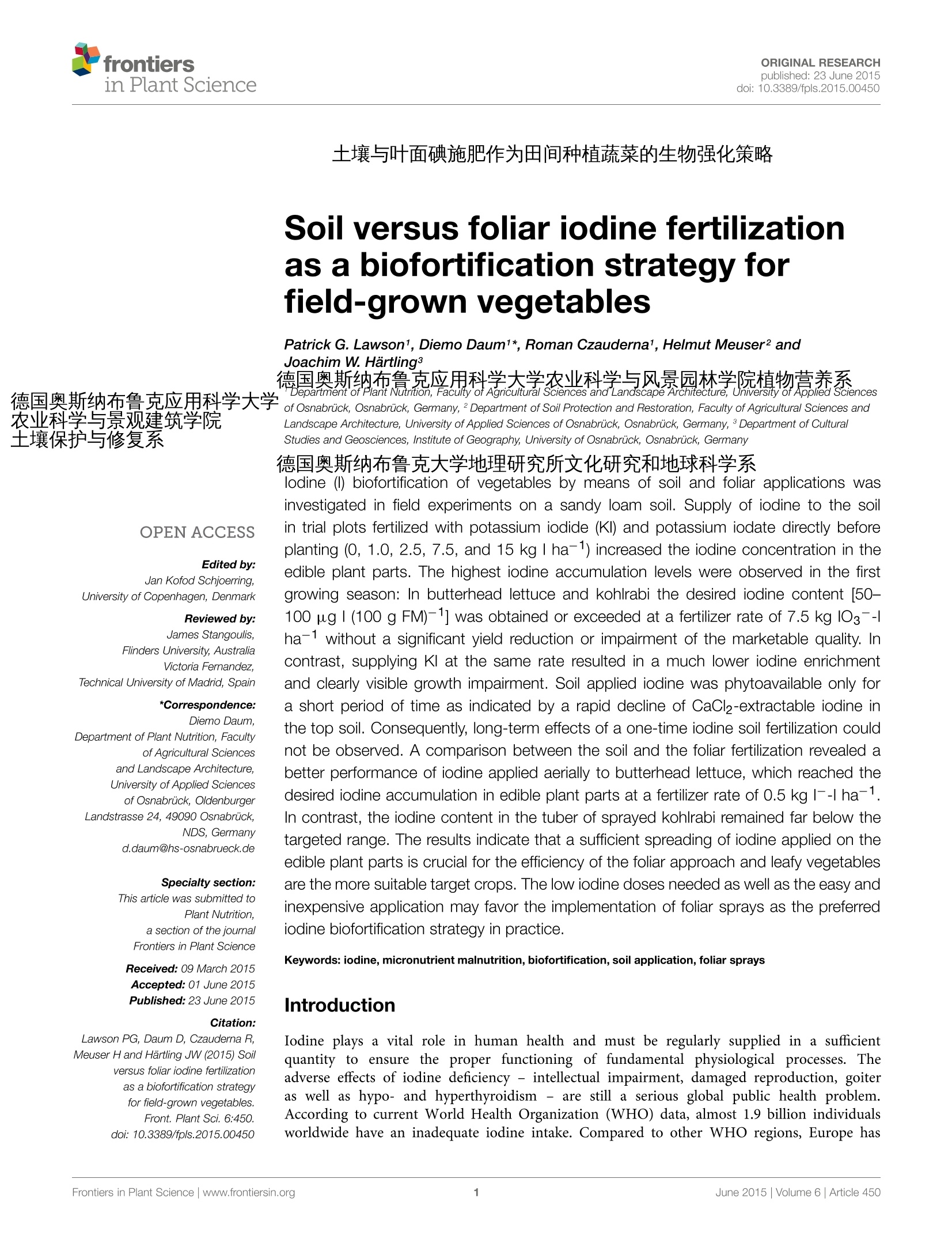
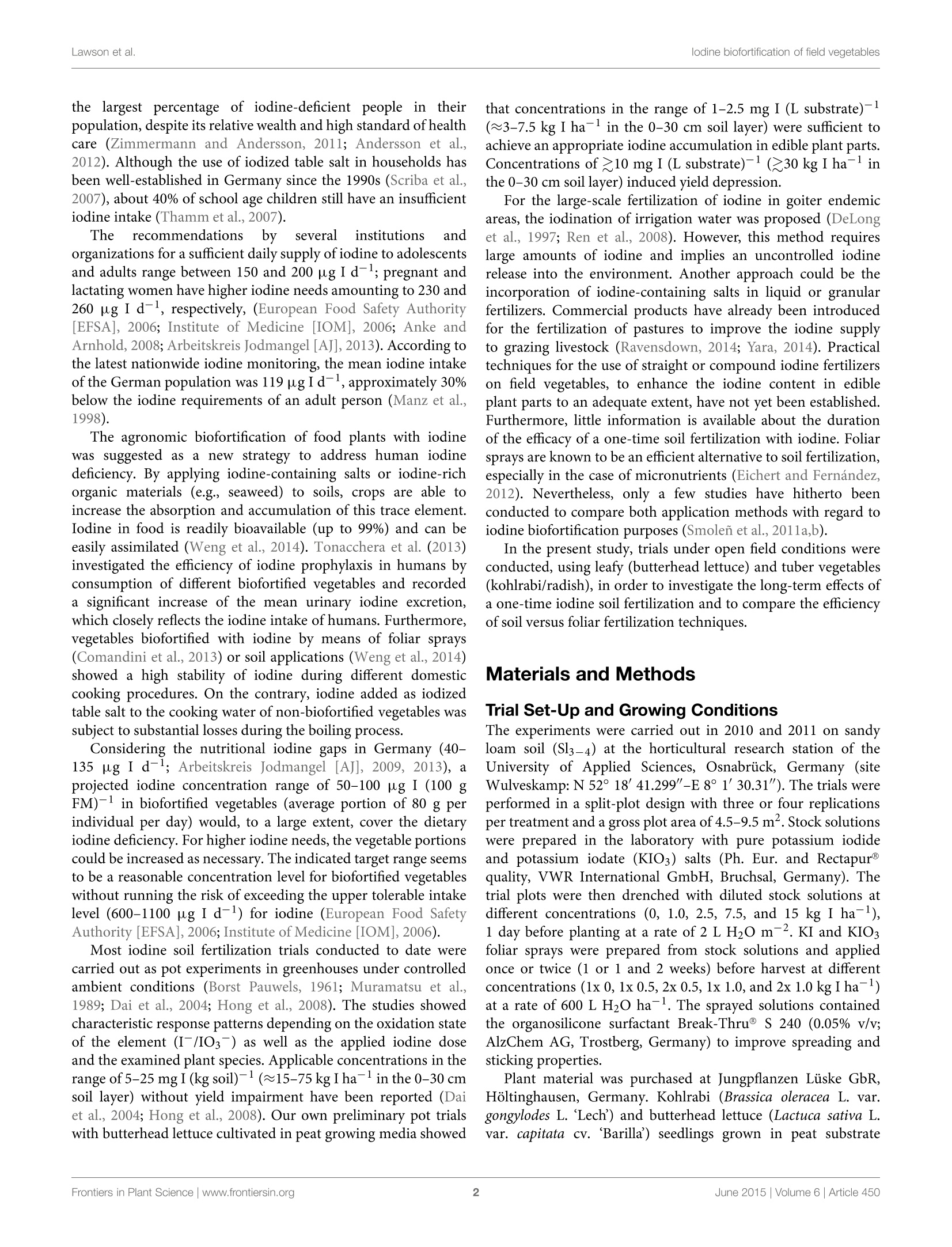


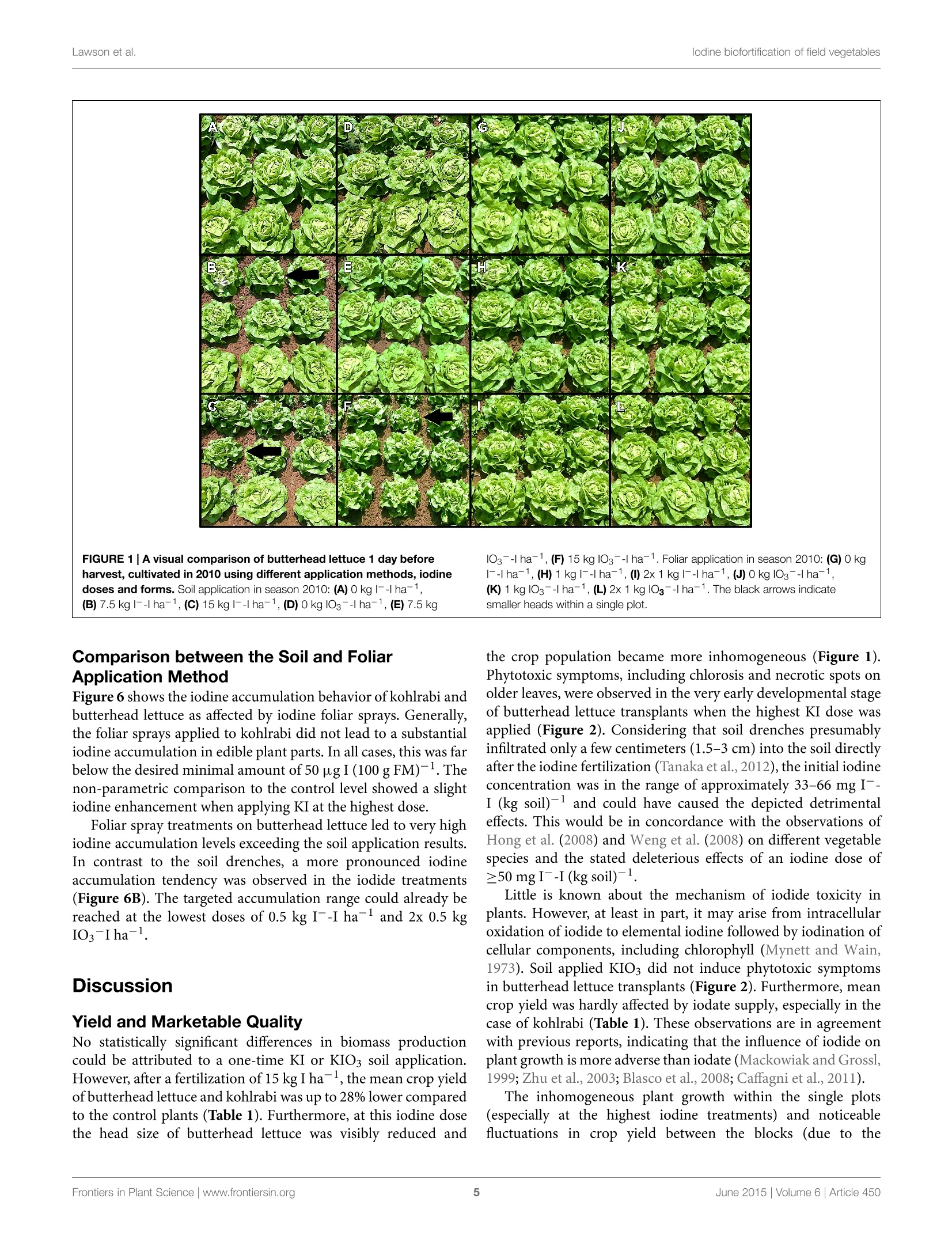
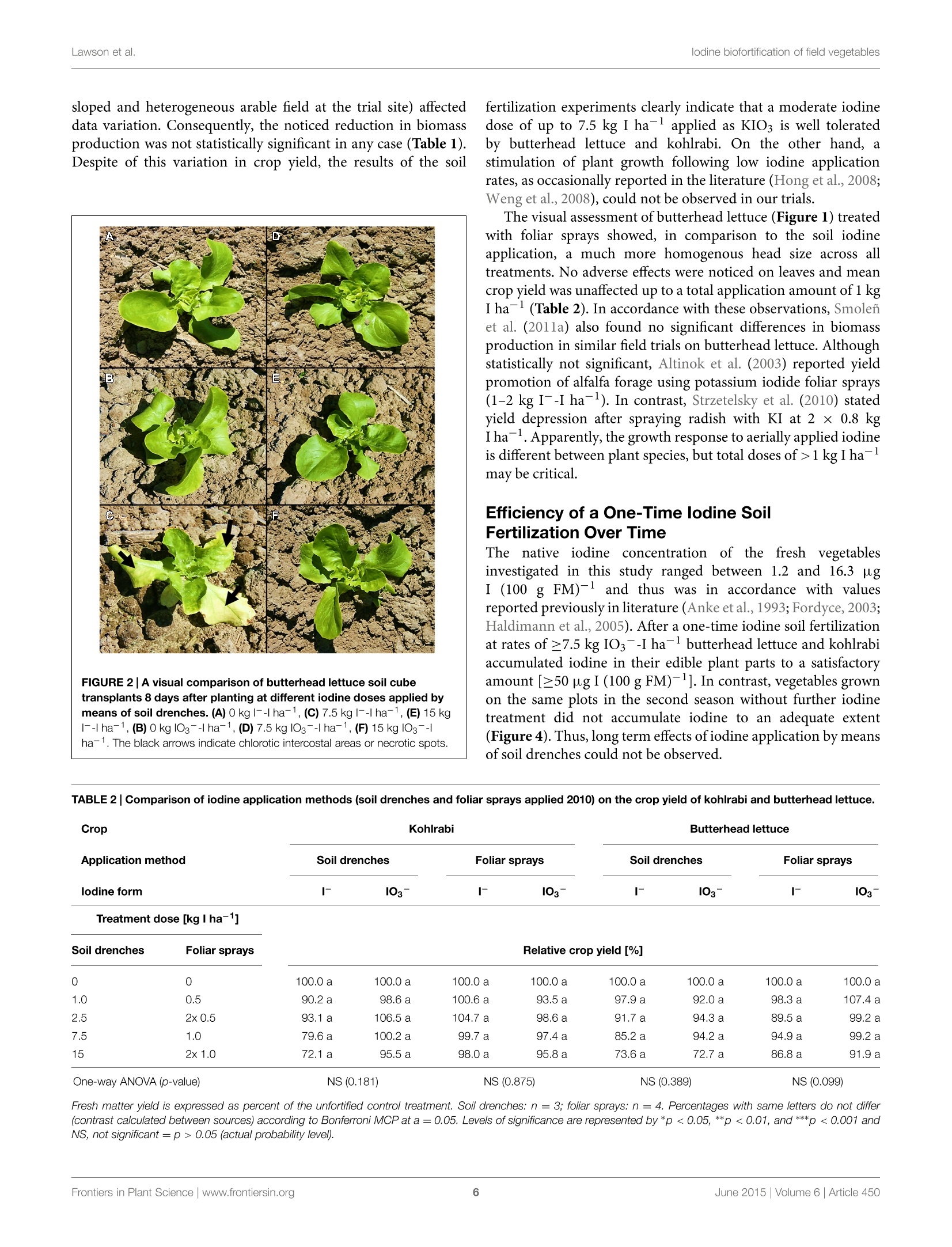
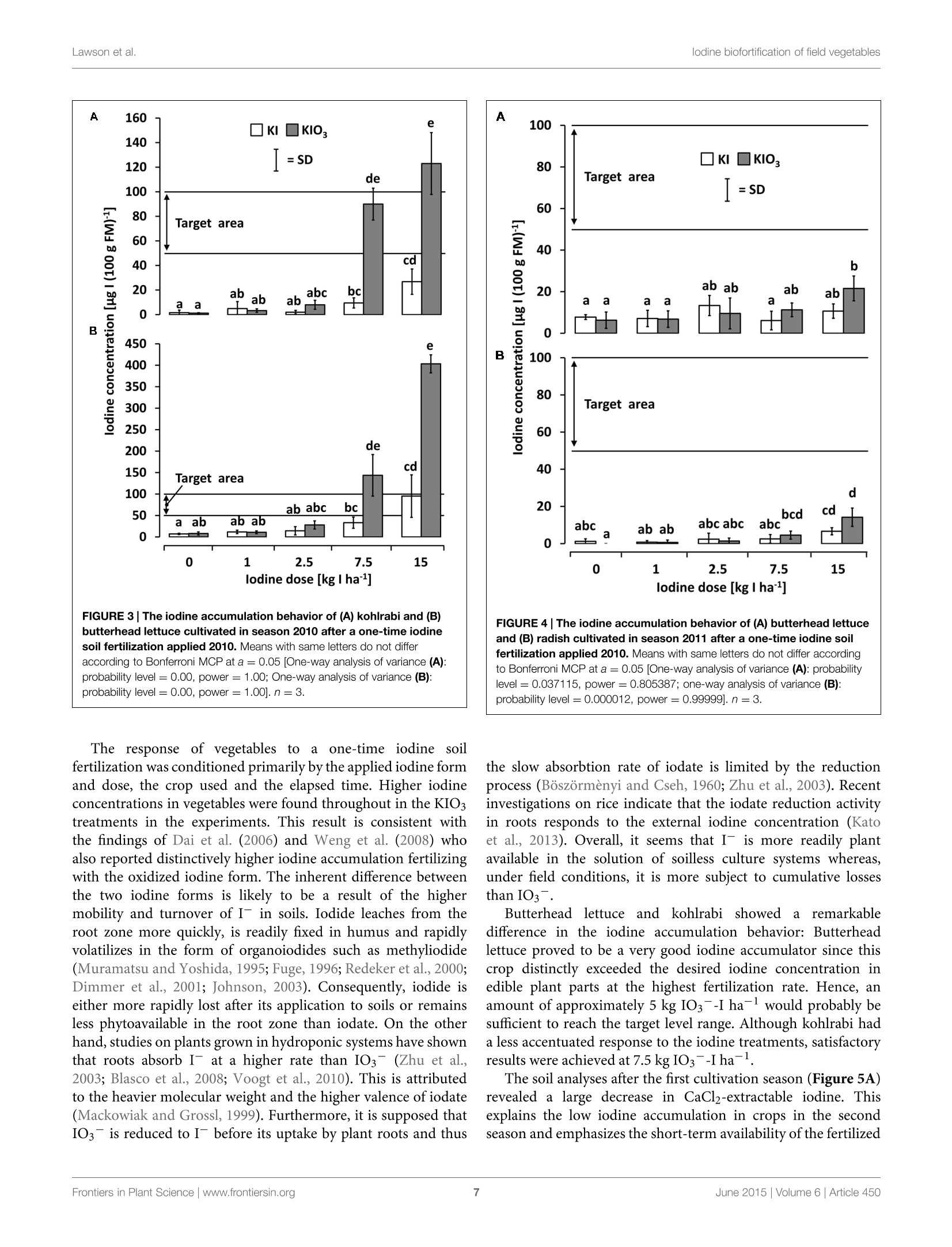
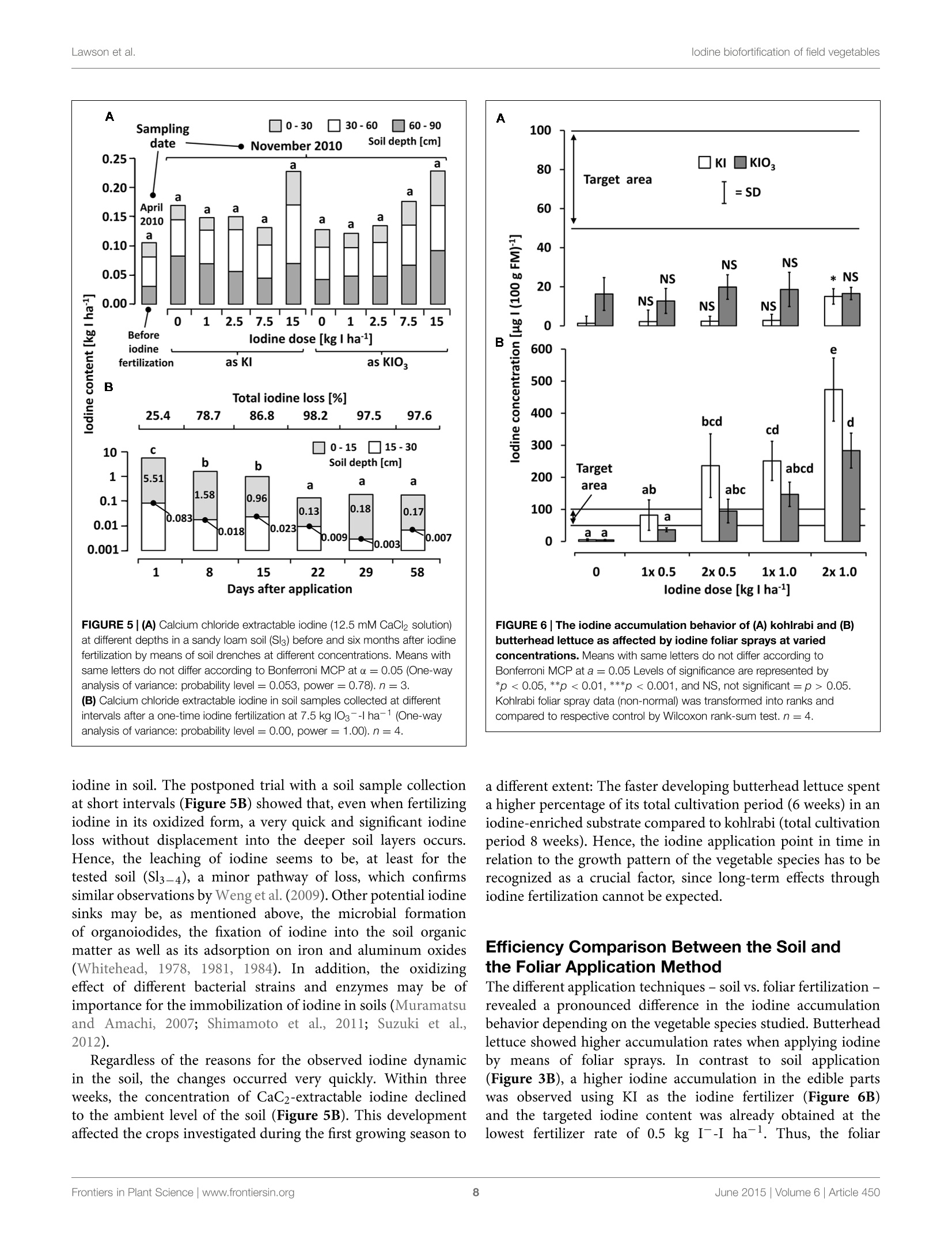
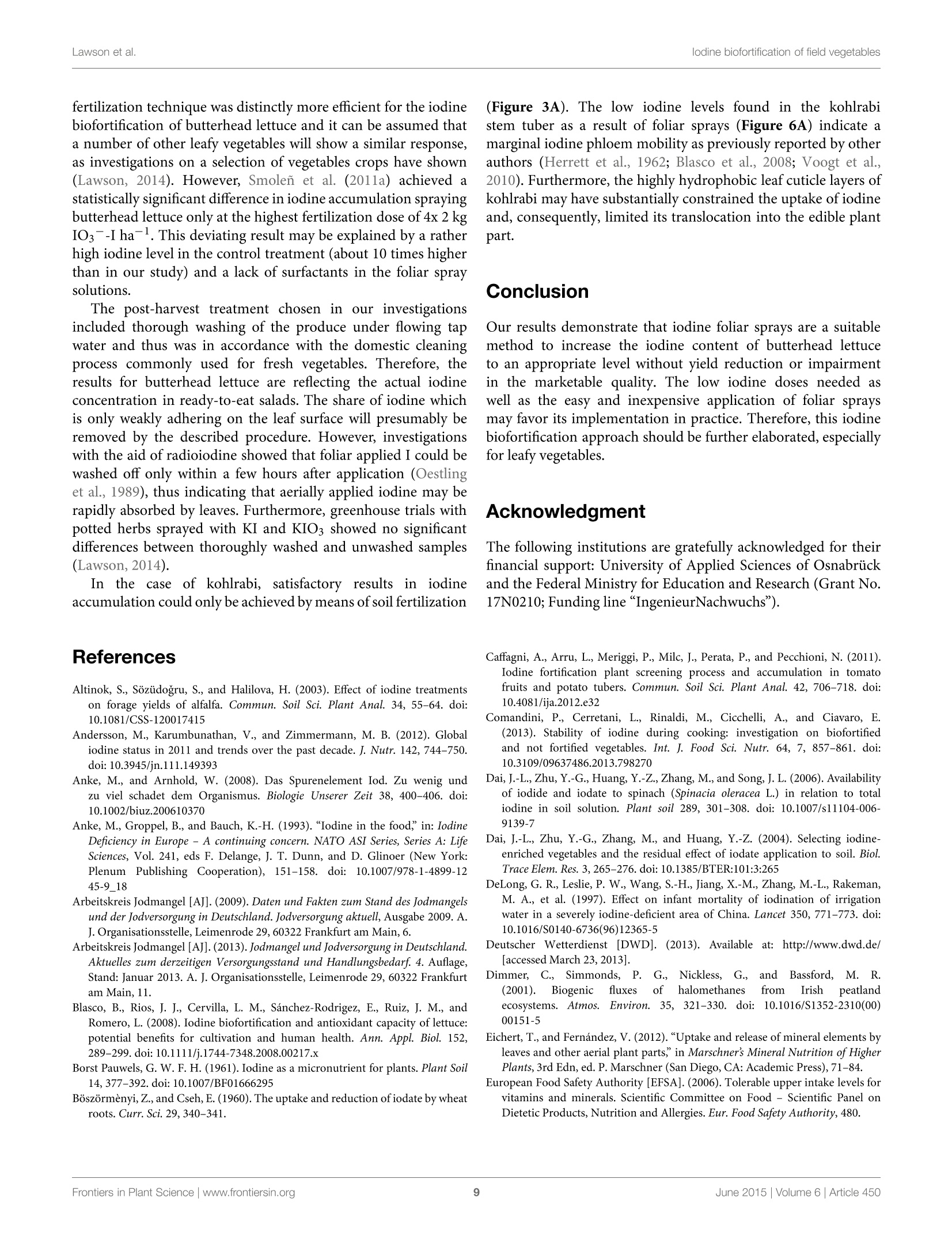
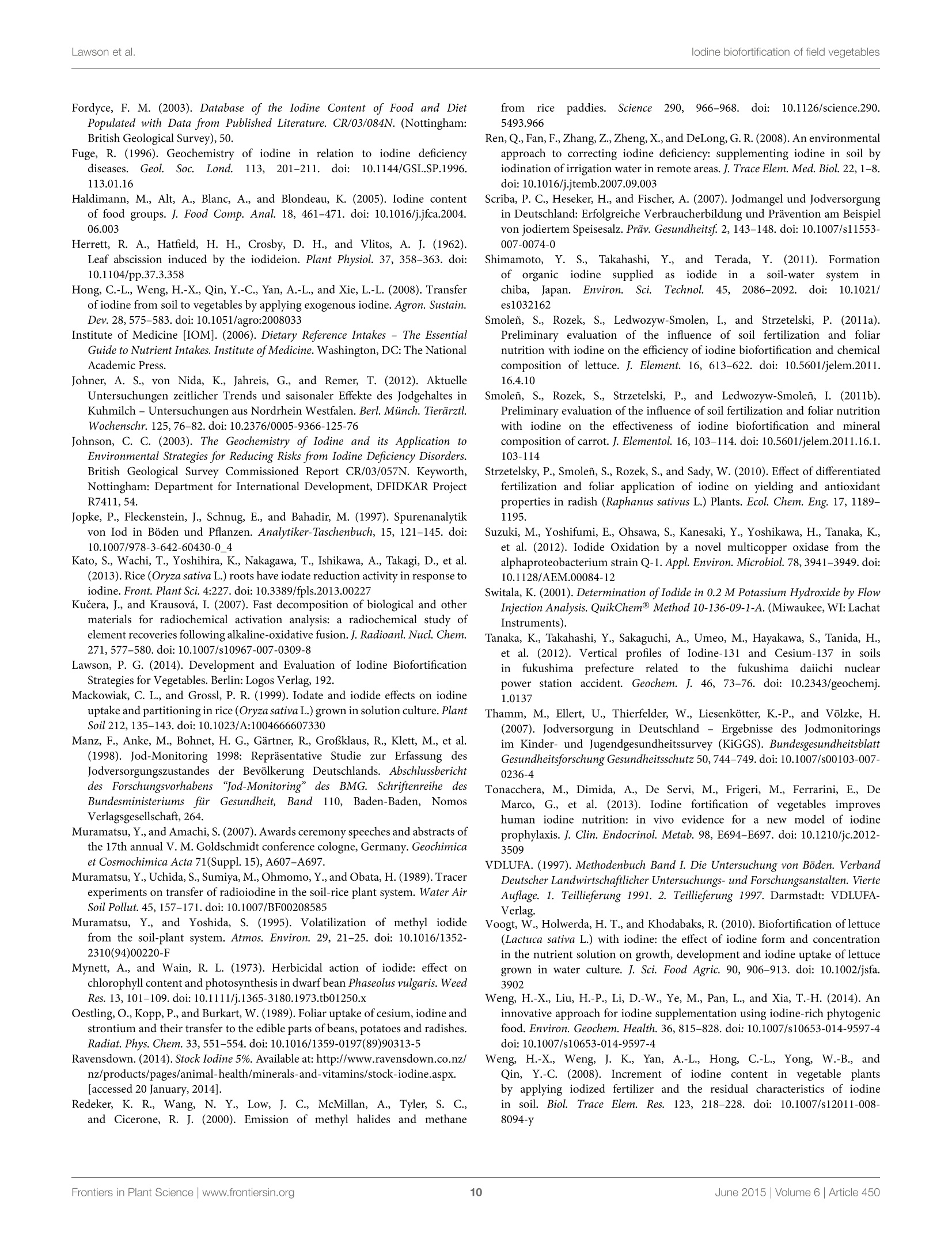
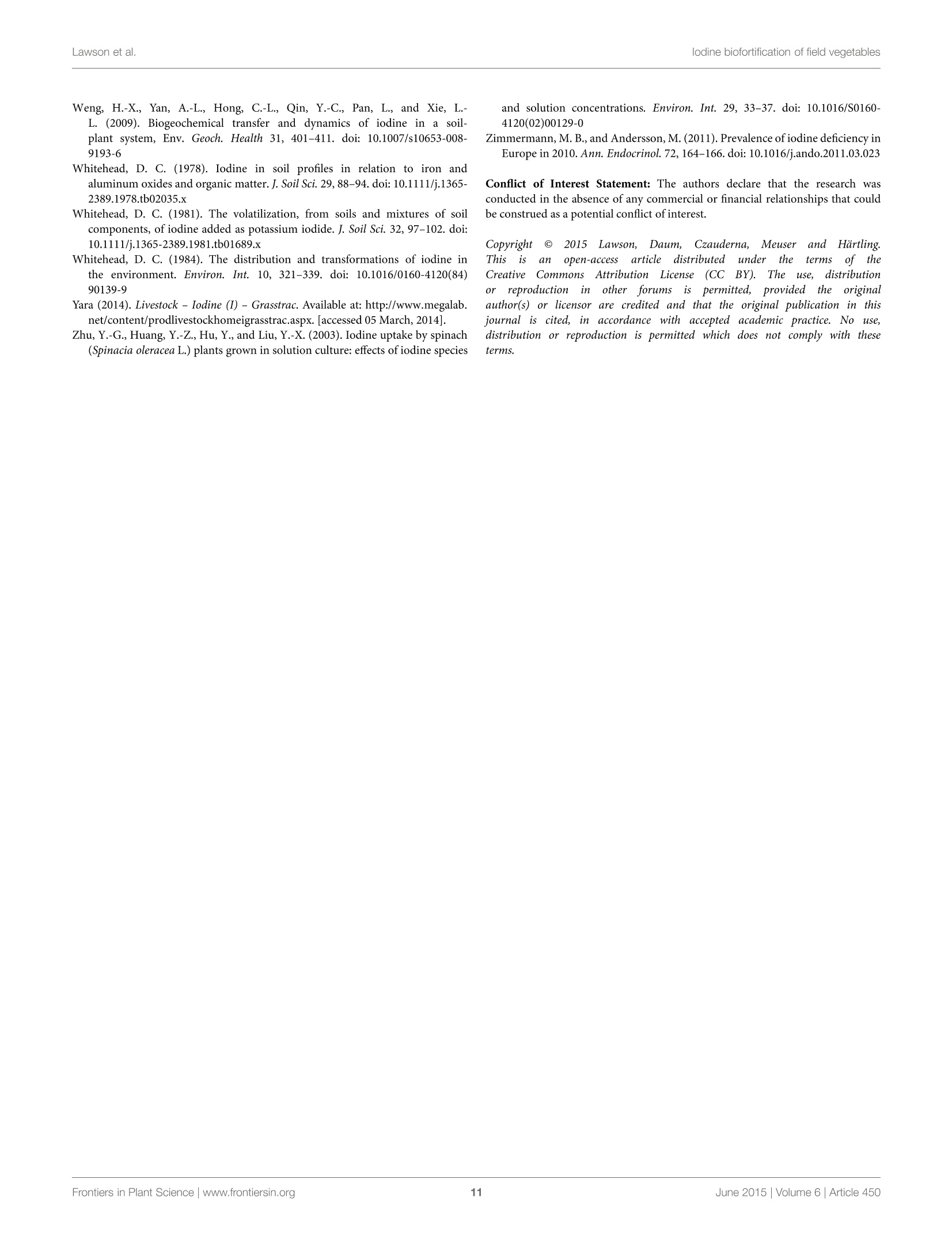
还剩9页未读,是否继续阅读?
中国格哈特为您提供《土壤碘含量检测的样品碱消解、氯化钙可提取碘含量检测的样品振荡》,该方案主要用于土壤中碘、氯化钙可提取碘检测,参考标准--,《土壤碘含量检测的样品碱消解、氯化钙可提取碘含量检测的样品振荡》用到的仪器有格哈特强力高重现振荡器LS500/RO500、格哈特快速干燥仪STL56、格哈特红外加热消解快速消化系统TTs125、德国移液器MM
推荐专场
相关方案
更多
该厂商其他方案
更多

